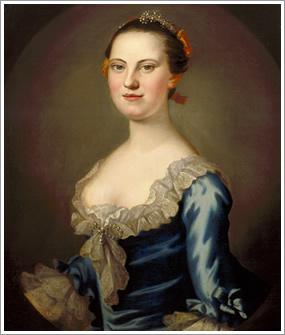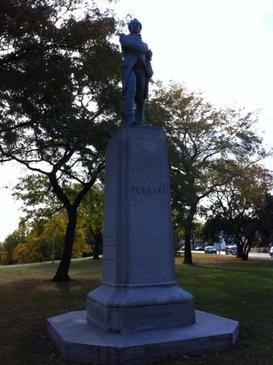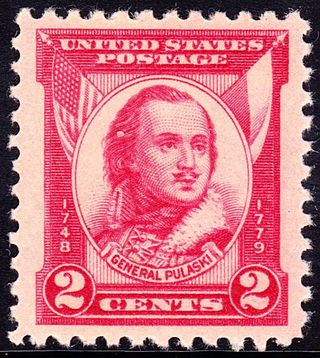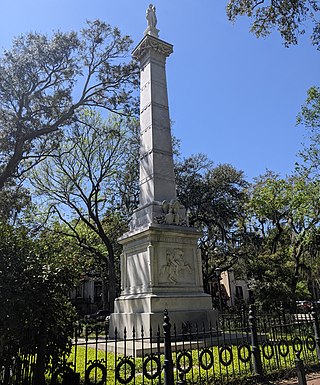Related Research Articles
Kazimierz Michał Władysław Wiktor Pułaski was a Polish nobleman, soldier, and military commander who has been called "The Father of American cavalry" or "The Soldier of Liberty".
Casimir Pulaski Day is a local holiday officially observed in Illinois, on the first Monday of March in memory of Casimir Pulaski, a Revolutionary War cavalry officer born in Poland as Kazimierz Pułaski. He is praised for his contributions to the U.S. military in the American Revolution and known as "the father of the American cavalry".

John Bubenheim Bayard was a merchant, soldier, and statesman from Philadelphia, Pennsylvania. He achieved the rank of colonel while serving with the Continental Army, and was a delegate for Pennsylvania to the Congress of the Confederation in 1785 and 1786. Later he was elected as mayor of New Brunswick, New Jersey.

William Jasper was an American soldier in the Revolutionary War. He was a sergeant in the 2nd South Carolina Regiment.

Major-General James Clinton was a Continental Army officer and politician who fought in the American Revolutionary War.

Mary Willing Byrd was an American planter. At twenty years of age, she became the step-mother of five children and managed the family and household at Westover Plantation in Charles City County, Virginia beginning her second year of marriage. Together Byrd and her husband, William Byrd III, had ten more children before he committed suicide in 1777. She determined what property to hold on to and what to sell of what she inherited so that she could pay off debts, preserve Westover Plantation, and retain some land for the Byrd children.

General Pulaski Memorial Day is a United States public holiday in honor of General Kazimierz Pułaski, a Polish hero of the American Revolution. This holiday is held every year on October 11 by Presidential Proclamation, to commemorate his death from wounds suffered at the siege of Savannah on October 9, 1779, and to honor the heritage of Polish Americans. The observance was established in 1929 when Congress passed a resolution designating October 11 as General Pulaski Memorial Day. Every President has issued a proclamation for the observance annually since.

Pulaski's Legion was a cavalry and infantry regiment raised on March 28, 1778 at Baltimore, Maryland under the command of Polish-born General Casimir Pulaski and Hungarian nobleman Michael Kovats de Fabriczy for their service with the Continental Army during the American Revolutionary War. The Legion consisted of one troop of lancers, two troops of dragoons, and 200 light infantry soldiers. It was one of the few cavalry regiments in the Continental Army.

Mikveh Israel Cemetery is the oldest Jewish cemetery in Philadelphia, Pennsylvania, giving evidence of a settled community as early as 1740. A number of outstanding patriots, pioneers, and other notables of the Jewish faith who made important contributions to the history and freedom of America during the Colonial and Revolutionary period were interred here, and for this reason, in 1959, by an act of Congress, the burial ground was designated as a unit of the Independence National Historical Park, while continuing to be maintained by the sponsoring Congregation Mikveh Israel. The cemetery was certified by the Philadelphia Historical Commission, and in 1971, it was listed on the National Register of Historic Places.

The Randolph family of Virginia is a prominent political family, whose members contributed to the politics of Colonial Virginia and Virginia after statehood. They are descended from the Randolphs of Morton Morrell, Warwickshire, England. The first Randolph in America was Edward Fitz Randolph, who settled in Massachusetts in 1630. His nephew, William Randolph, later came to Virginia as an orphan in 1669. He made his home at Turkey Island along the James River. Because of their numerous progeny, William Randolph and his wife, Mary Isham Randolph, have been referred to as "the Adam and Eve of Virginia". The Randolph family was the wealthiest and most powerful family in 18th-century Virginia.
Casimir Pulaski High School is a public high school located on 2500 W Oklahoma Ave in Milwaukee, Wisconsin. Casimir Pulaski is part of the Milwaukee Public School system. The school had 1600 students during the 2004–2005 school year.
Samuel Bowen was an English entrepreneur and farmer who established an estate in Savannah, Province of Georgia, where he cultivated the first soya beans in North America. While earlier sources credited Benjamin Franklin with the introduction of the soya bean to North America, later research has shown that Bowen was responsible.

Count Casimir Pulaski is a public artwork by American artist Joseph Kiselewski located in Pulaski Park, which is in Milwaukee, Wisconsin, United States. The bronze statue is a 6-foot, full-length portrait of Count Casimir Pulaski standing atop a 17-foot granite pedestal.

General Casimir Pulaski is a bronze equestrian statue of Casimir Pulaski, a military man born in the Polish–Lithuanian Commonwealth. He joined the military at a young age, fighting for removal of the king, who was backed by Russia. After his side lost the war, he fled to Paris, where he met Benjamin Franklin. Impressed by Pulaski, Franklin wrote a letter of recommendation to George Washington, suggesting he would be a helpful soldier during the American Revolutionary War. After arriving in the U.S., Pulaski eventually was promoted to Brigadier General and commanded a cavalry unit, the Pulaski's Legion. He died in 1779 due to injuries sustained in battle.

William Bayard Jr. was a prominent New York City banker and a member of the Society of the New York Hospital. He was a close friend to Alexander Hamilton, who was taken to his Greenwich Village home after his famous duel with Aaron Burr, where Hamilton later died.

Casimir Pulaski was a Polish nobleman, soldier and military commander who has been called "the father of the American cavalry". He has had hundreds of monuments, memorial plaques, streets, parks and similar objects named after him.

The Casimir Pulaski Monument in Savannah, or Pulaski Monument on Monterey Square, is a 19th-century monument to Casimir Pulaski, in Monterey Square, on Bull Street, Savannah, Georgia, not far from the battlefield where Pulaski lost his life during the siege of Savannah.

Greenwich Plantation was a plantation founded in colonial Savannah, Province of Georgia, in 1765, on land now occupied by Greenwich Cemetery. The 100-acre (0.40 km2) site included a plantation house and private cemetery, and was located on the Wilmington River, about 3.5 miles east of the Savannah colony. It was located immediately to the north of Bonaventure Plantation, which existed until 1868 on land now occupied by Bonaventure Cemetery. Its mile-long driveway still exists to the left of Bonaventure's main gates.
References
- ↑ The American Genealogist, p. 199
- ↑ The American Genealogist, p. 196
- 1 2 Hymowitz & Harlan 1983.
- 1 2 Aoyagi, William Shurtleff; Akiko (14 June 2015). History of Soybeans and Soyfoods in the United Kingdom and Ireland (1613-2015): Extensive Annotated Bibliography and Sourcebook. Soyinfo Center. p. 48. ISBN 978-1-928914-76-1.
{{cite book}}: CS1 maint: multiple names: authors list (link) - 1 2 3 The American Genealogist, p. 197
- ↑ Kajencki, Francis C. (2001). Casimir Pulaski, Cavalry Commander of the American Revolution. Southwest Polonia Press. p. 220. ISBN 978-0-9627190-5-9.
- 1 2 Pinkowski, Edward (1997). "General Pulaski's body". Poles in America Foundation, Inc. Retrieved 26 April 2014.
- ↑ Polish American Journal, 1996
- ↑ Szczygielski 1986, p. 393.
- 1 2 3 Greenwich Cemetery - Forest City of the South
- ↑ Bulletin. The Society. 1997. p. 15.